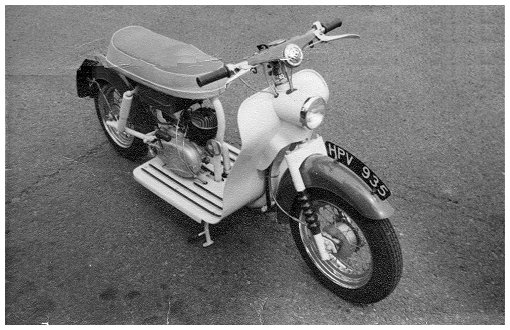
Ipswich in Suffolk certainly isn't a place that many people would associate with the production of motorised two-wheel vehicles, but it was the origin of a few obscure machines.
The Ostler Mini Auto Cyclemotor from 1948 would probably count as the town's first offering - if a suite of castings for home machining to a set of plans, then built up into an engine for fixing to a bicycle, might qualify?
This pioneer of Britain's cyclemotoring boom was listed by Craftsmanship Models before fading away in the early 1950s with few examples having been completed.
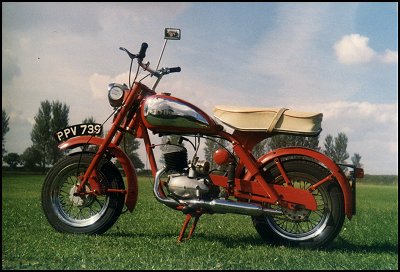
The second chapter probably began in 1958, with the building of a prototype scooter based on a 99cc Villiers 4F or 6F/H motor unit. The small, fat wheels comprised a typical scooter specification of 4-inch British Hub Co 'Motoloy' full width hubs laced into remarkably wide chrome-plated rims of unconfirmed make. They were only stamped 'Made in England' deep in the well, but may have been a derivative of the rims that were 'specially made' by Dunlop for Dayton's scooter range.
The Dayton Albatross was shod with 12 × 4.00 tyres for a total wheel diameter around 20 inches, though the smaller Flamenco could be fitted with 12 × 3.50 for around a 19-inch at 3½ inches width. This size of radial-ribbed tread pattern was believed to be listed by Bridgestone about this time, so may be what we see fitted to the front wheel of this prototype.
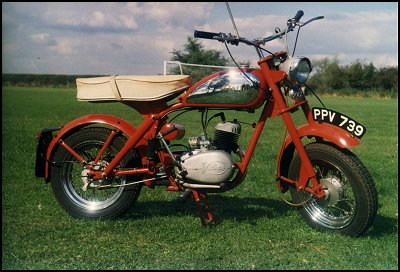
What appears to have been an own-make telescopic fork set sealed by Bantam style gaiters, is mounted in a curling single-tube main frame, and swing-arm set, where the rear wheel spindle is mounted from above the arm (presumably to lower the ground clearance?)
The headlamp nested in a projection from the front apron, which continued back to form a footplate set beneath the engine.
Unlike other 99cc scooters of the period (DMW Bambi, Mercury Dolphin, and Mercury Pippin), which required a special Villiers forced-air motor, the naked rear frame design of the Stella allows for air circulation around the cylinder without the need for fan-cooling, so the standard 4F or 6F/H engine could be used, and the exhaust pipe exits down through a hole in the footplate. With the rider sitting above the engine, a petrol tank hangs beneath the dual-seat, to feed directly into the carburettor below.
Mudguards are generously side valanced, and the rear guard moves with the wheel. A handlebar nacelle mounts an AC horn by Clear Hooter Ltd, speedo, and Wipac lighting control switch.
The new model was registered HPV 935 about 20th February 1959 by Ipswich Borough, and is pictured wearing its first bar-type road fund licence, the last year this style of tax disc was issued. With the PV record series listed as 'destroyed', there is little more that can be positively confirmed, though from printed letter headers of the Stella Motor Scooter Company, it's very likely to have been registered as a Stella.
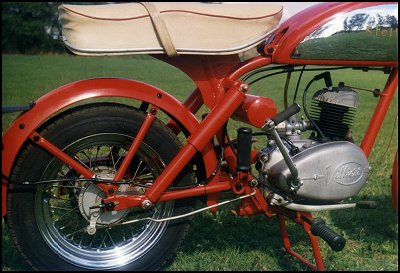
There's no evidence to indicate how many more (if any more at all) were built, but everything went fairly quiet for a while, until the business seems to have actively commenced production of a miniature motor cycle, the few surviving examples of which appear to date around the early 1960s.
Both the scooter and miniature motor cycle are credited to the design of Maurice Cox, who supported by father Victor Cox and R K O Cooper as co-directors, are believed to have more formally arranged the business to construct the miniature motor cycles.
Trading as the 'Stella Motor Scooter Company', letter heads listed the address from Victor's home at 506 Felixstowe Road, Ipswich, while the bikes were actually built from a unit on Sandy Hill Lane near Ipswich docks.
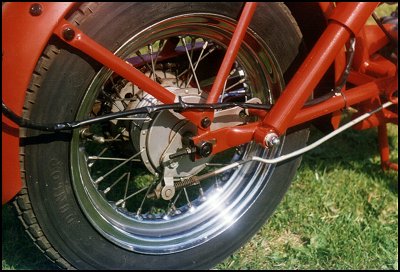
Most of the work seems to have been performed in the evenings, since Maurice also held down a full time job as an architect in London, commuting every day on the train. Joined by a 'moonlighting' welder known only as 'Jock' who worked at Petric Caterpillar Tractors in the adjacent unit during the day, the two are reported to have often laboured long into the night.
Backing for the venture seemed to have chiefly come from Victor, who had previously run a movie camera shop in Ipswich and cinema at Manningtree (described as a 'Tin-Tabernacle' sort of building that earlier housed the Paragon Motorcycle Works 1914 - 1923).
The mini-motorcycle was of tubular frame welded construction with swing-arm rear suspension and long, leading-link forks, all seemingly of Stella's own manufacture. The petrol tank was bought in as two pressed halves, and welded together down the centre line, then metalwork finished in listed optional colours of red, black, blue, green, white, or yellow.
Based upon the same wheel specification as the scooter, Stella's mini-motorcycles were fitted with Dunlop 12 × 3.25 block tread pattern tyres, that do seem a little on the narrow side for that width of rim, but may have been a necessary concession to assembly clearance, looks and cost.

The motor cycle wheel-base measured 45½ inches, for a total length of 67 inches, and saddle height a mere 28 inches.
It seems that early models of the miniature motor cycle were installed with hand-change 4F or 6F/H units, presumably utilising motors that may have been intended for Stella scooters. Once these cable-change engines were used up, further minibikes were generally fitted with the 99cc, 2.8bhp Villiers 6F 2-speed foot change unit, though a number of machines were also built up with the 4.7bhp Villiers 9F Kart motor variant.
Several sources suggest 125cc motors were also fitted, however, as yet, only one such machine has been positively proposed, which was fitted by Stella with a small box sidecar and used about the town of Woodbridge carrying window cleaner's ladders.
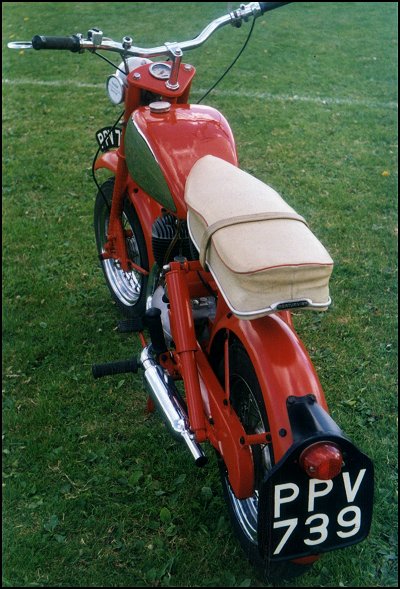
Initial sales were either direct from the works or through local dealers, and the few surviving vehicles would appear to date around 1961 to 1962, including the featured test machine, frame number 980145, which was registered on 15th October of that year. This extraordinary surviving example of the Stella marque still remains in the ownership of its very first buyer, and complete with all preserved works literature, currently stands on display at Ipswich Transport Museum. The bike was bought in optional kit form to avoid purchase tax, giving a 15% discount, and further 2½% off for cash sale, so £60-13s-9d - and it's still got the factory receipt! It is of Stella's top specification with the tuned 4.7bhp 9F Kart engine, dual seat, rear footrests, optional chrome panelled tank, fitted speedometer, tool kit and manual. A mere 3,313 miles are recorded on the 70mph Smith's speedo set into the top yoke, and this certainly is the very best example of the eight known surviving motor cycles.
There are a number of 'original thinking' features about the mini-motorcycle design, the most striking of which becomes observed as soon as you go to lift the bike off its stand. The only thing to get hold of is the underneath of the dual seat, at which point you realise there is no rear frame section and the passenger half of the saddle is completely unsupported overhang!
This means the top mountings on the rear suspension units are taken from an untypically forward location, resulting in the struts leaning at a remarkable angle of 50° from the vertical, which certainly requires stronger than normal springs to compensate the leverage disadvantage. It appears these especially long suspension legs are of Stella's own manufacture, with the spring units proving of welded construction, which require cutting apart to access the working components. Inside it's found that the function was initially oil damped, but this mechanism generally proves inoperative due to seemingly low oil levels. It seems fairly certain the scooter suspension units would have been of comparable construction.
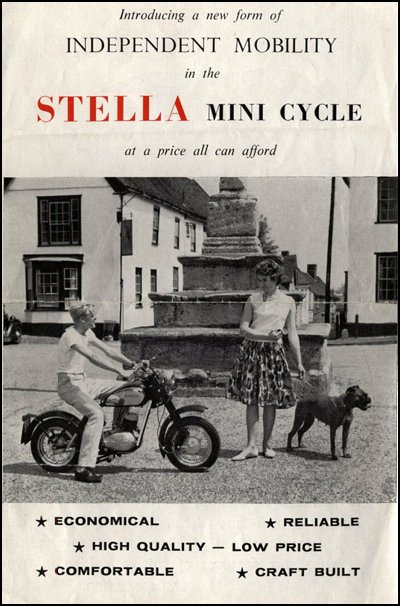
Unlike the scooter, rear wheel spindle location on the motor cycle is conventionally mounted from lugs in-line with the arm.
On the left-hand side, the rear mudguard brackets are taken off the top of the chainguard, and most unusually, the whole back assembly moves with the suspension! Further forward, the front footrest bar crosses the full width of the frame where it also acts as the stand pivot. Handlebars are mounted in a cycle 'central stem' style, while the Miller AC horn and electrical set is driven direct from the flywheel generator, so uses no battery in the system.
Up front, the main fork tubes appear particularly long as a result of the small wheels, while at the bottom of these, the dainty leading-link arm only extends 4" forward of the pivot to the axle centre, and travel in the system is probably unlikely to reach 1½".
The Villiers type S.19 carburettor is equipped with flood facility and shutter strangle on the filter, so however cold it gets, you're always going to be able to richen the motor enough to start. Little additional resistance to starting is offered despite the higher 9:1 compression ratio of the 9F 'sports' motor, and administering a few jabs at the kick-start, the engine bursts into life with a deep, mellow throbbing from the Burgess silencer.
Even while warming up the engine, it's obvious the 9F variant is appreciably sharper than the prosaic standard units, its responsiveness to throttle and eagerness to rev being most untypical of Villiers factory motors.
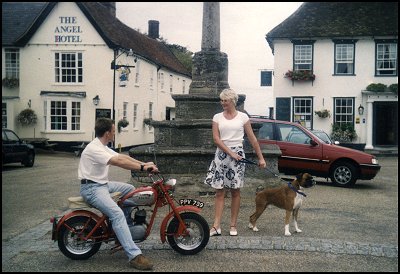
Gearshift is located on the right foot, moving up for first, and down through neutral into second (top). Winding on the throttle, the bike simply surges away, and that Kart motor certainly delivers quite an advantage in terms of the power to weight ratio. This 9F-powered test bike actually manages to indicate up to 50mph on the speedo, which on such a little machine, really does feel to be motoring! For those traditional riders who think that proper motor cycles only have big wheels, from the riding position you cannot see their size, and have no impression whatsoever of their small proportions. Between the suspension and fat pneumatic tyres, the machine rides quite comfortably, while still proving particularly nimble and surefooted on cornering. Even today, the Stella demonstrates itself a very practical little town bike, and is still capable enough for commuting moderate distances - as long as you're not in too much of a hurry!
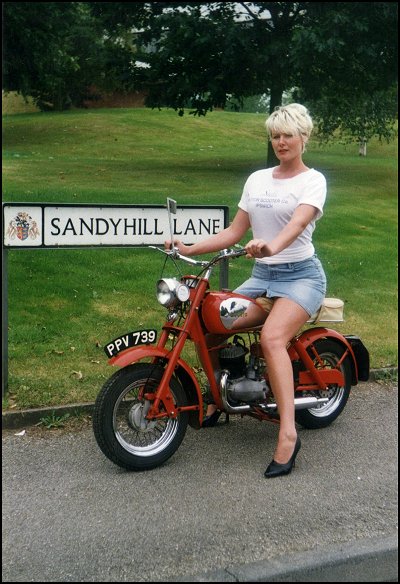
Riding the Stella scooter would probably have been fairly close to riding the Stella mini-motorcycle, since both machines had the same wheels, similar suspension arrangements, and frame geometry.
Stella's breakthrough appeared to come with an export order to the States, however this was to prove the downfall of the enterprise. The story goes ... an initial batch of 60 bikes was built up and shipped, only to become held-up by a strike at New York docks. As the charterer's failure to unload the cargo began to accumulate demurrage charges, the shipment became seized in lieu of payment. Everything was lost through no fault of their own, meanwhile, back in Blighty, Stella's pressing creditors reportedly forced the business into liquidation! Talk about the good old days!
As best as can be ascertained, this was 1963, so the Stella Motor Scooter Co. is now believed to have existed for some 4 to 5 years, over which period, it seems unlikely that production exceeded 200 machines.
The source of some of the proprietary components can be identified since a couple of Stella engine numbers notably appear among Villiers's records of batches specifically issued to the Excelsior works in Birmingham, while the petrol tank pressings are the same ones used on Excelsior's 98cc Consort model.
The general styling and wide wheels made an unusual combination to our eyes, but across the Atlantic, these different fashions already flourished! Based on the image of period Harley and Indian motor cycles, this very style of minibike had become popularised since 1949 with the Cushman Eagle, Powell P-51, and later Mustang. The constantly pipe-smoking Maurice is quoted as having said to Anglian customers, that the Stella mini-motorcycle was designed and built for 'on-campus' use by American students. Its pioneering 'custom' look was certainly no accident, the individual styling being carefully crafted to another intended market - half a world away!
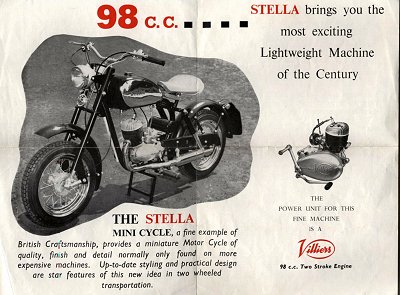
Despite producing a formal printed sales leaflet for the mini-motorcycle, Stella never seems to have attended major shows, so the period motor cycling press never latched on to it. The little bike that never quite made it to the mainstream, simply melted away into local legend - a complete unknown to the wider world! To boldly build a machine from scratch on the fringe of East Anglia, designed for market on the far side of the globe, the Stella was a valiant effort that deserves a far better epitaph than 'Lost in Obscurity'.
It seems there may have been some consideration to try to revive the Stella scooter, since Maurice Cox approached Peter Davey at Davey Bros. Motorcycles in Alan Road, Ipswich in 1963, enquiring if he might be interested in selling his Stella scooters, and leaving Mr Davey with this only known photograph.
Any thoughts to revive the Stella scooter project about this time may, however, have been becoming a little academic. The original Villiers cable-change 4F motor became adapted in 1956 to create the 6F foot-change unit, then a 6F/H cable-change variant listed from 1957, and the 4F dropped in 1958. The Villiers 6F motor was subsequently deleted from listings in the early 1960s, so if the Stella scooter had become returned in any production numbers, then Maurice would probably have experienced difficulty in engine supply.
Nothing further was heard about reviving Stella production, until Maurice returned to Davey's about 1966, to dispose his last remaining parts, exhaust pipes, mudguards, and speedo heads, for just a few pounds.
Just as Benz called the Mercedes after his daughter, we wonder who might have been the mystery lady behind the Stella name?
Eight surviving examples of the miniature motor cycle are so far recorded, frame numbers 980115, 980119, 980121, 980123, 980138, 980142, 980145 and one other.
No examples of the Stella scooter are known to survive.
[Text and photos © 2010 M Daniels. Period documents from IceniCAM Information Service.]
This article is a revised and updated version of Star Trek. It was produced for the Vintage Motor Scooter Club and appeared in the May - June 2010 edition of their magazine. It is reproduced above with the same pictures that they included in their club magazine.
Somewhat oddly, one picture they chose not to use was the one of Stella's only scooter. As it's referred to in the text, here it is:
